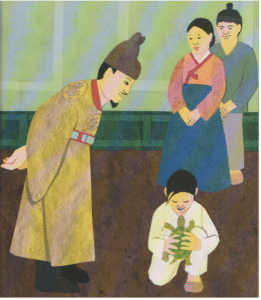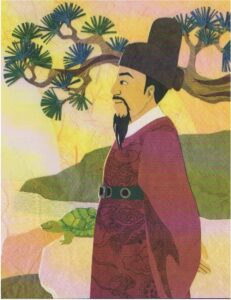
The Turtle Ship
- Fiction
- Set in Korea
Keywords: war, boats, animals, persistence
Loosely based on the true story of Admiral Yi Sun-sin and his Turtle Ship, this delightful tale introduces young readers to a fascinating episode in Korean history and naval engineering.
Long ago in Korea, a young boy named Sun-sin spent his days playing with his pet turtle Gobugi and dreaming of sailing around the world. As a poor villager, though, his dream to travel seemed impossible. Then one day, the king’s court announced a contest to find the best design for a new battleship to defend the land from invaders. The winner would sail the ocean with the royal navy.
Determined to win, Sun-sin attempts to build an indestructible battleship with a few found items. Each attempt fails miserably against the powerful sea, and with it Sun-sin’s dream also sinks to the bottom. Turning to Gobugi for comfort, Sun-sin notices how his pet turtle is small but mighty, slow but steady, and impossible to sink. Suddenly, Sun-sin has a great idea.
Genre: Historical Fiction
The Turtle Ship is a creative interpretation of historical events and figures. The historical figure Admiral Yi Sun-sin (1545–1598) (pronounced: ee SOON-shin) is credited with inventing and designing the first “turtle ships” (Gobukson or Geobukseon; pronounced: kaw-BOOK-suhn). In the 1590s, they proved instrumental in defending the country against invasions from Japan.
At that time, the Korean nobility (yangban; pronounced: yahng-bahn) was in turmoil due to rivalries and political intrigue. The family of Admiral Yi Sun-sin was also yangban, but Admiral Yi’s father and grandfather tended to avoid politics. Yi Sun-sin was known as a dedicated soldier who worked tirelessly to turn his great ideas into successful defense strategies to protect the Korean kingdom from invasion.
In contrast, the book’s protagonist, also named Sun-sin, lives by the sea in a fishing village (eochon; pronounced: AW-chohn). The villagers are humble folk whose social reality is far removed from the aristocracy.
Illustrations
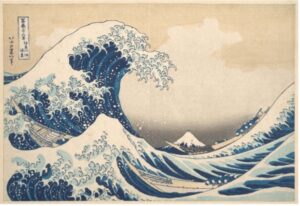
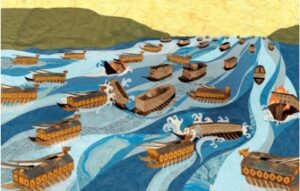
The Turtle Ship tells an original story inspired by historical figures from the 1500s. The illustrations for The Turtle Ship are similarly inspired by history. For example, the shape of the waves in the illustrations resemble the famous woodblock print The Great Wave off Kanagawa (c. 1830–1831) by the Japanese print designer Katsushika Hokusai (1760–1849). This work is also known as The Great Wave or simply The Wave.
History of Korean Shipbuilding
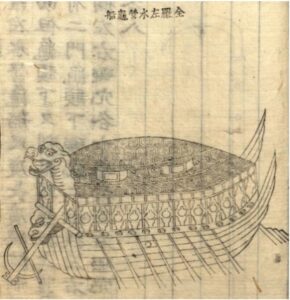
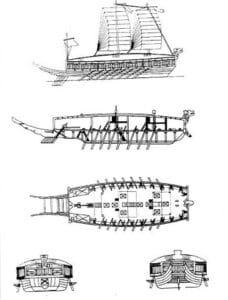
Korean seafaring and navigation date back thousands of years. The Geobukseon or turtle ship was successfully used to defend Korea in naval battles with Japan in the sixteenth century. The turtle ship was a great new idea in shipbuilding and a major accomplishment in both Korean maritime and world naval history. The ship itself was ironclad to repel attacks from above. Spikes lined the hull, and the bow of the vessel was carved to resemble the head of a dragon. The dragon could be used to fire canon or “spew flames and smoke to confound enemy ships.”
Turtles as Symbols
In Korean culture, turtles are symbols of longevity and loyalty. Turtles, along with dragons, have a special status in Korean mythology, and both have inspired works of art and design.
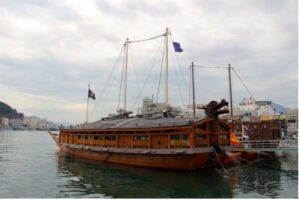
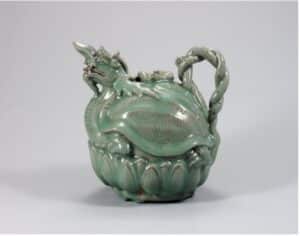
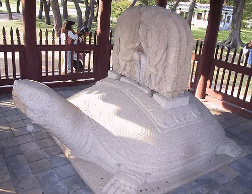
Admiral Yi Sun-sin
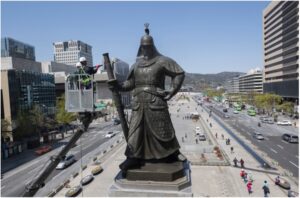
As mentioned, the family of the real Admiral Yi Sun-sin was yangban. Yi Sun-sin was known as a dedicated soldier who worked tirelessly to turn his great ideas into successful defense strategies to protect the Korean kingdom from invasion.
Korean Clothing: Hanbok
Hanbok (pronounced: HAHN-bohg) is a general term for Korean clothing. Hanbok come in many varieties, and as in all fashion, hanbok styles change over time and vary by region. While hanbok are featured in museum exhibits, folk villages, and historical dramas, people continue to wear hanbok for ceremonies and in everyday life.
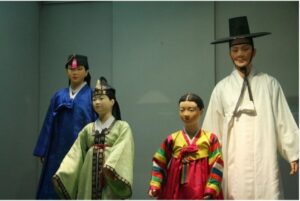
A woman’s hanbok consists of a short jacket (jeogori; pronounced: CHAW-GOH-lee) worn over a long, flowing skirt (chima; pronounced: CHEE-mah); this outfit has many variations and accessories. Men’s hanbok styles consist of a long jacket worn over pants (baji; pronounced: PAH-chee). Hats worn by men show their age and social status. More elaborate hats are worn by people with greater status or age. Hanbok are still worn in everyday life today.
In The Turtle Ship, Sun-sin and his family live in a fishing village. They dress in plain hanbok, with plain white for Sun-sin, and white or drab colors for Sun-sin’s father and the other men in the village. Sun-sin’s mother, in contrast to the royal women and the ladies of the court, wears no adornments with her hanbok.
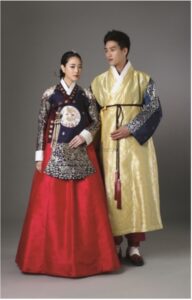
The clothing of the poor fishing villagers and of the common folk at court is contrasted with the ceremonial dress of court officers, nobles, and the king.
Korea long history includes many cultural variations over time, across regions, and throughout world politics. In the era depicted in The Turtle Ship, the Joseon Dynasty (1392–1897) (pronounced: choh-SUHN), various hairstyles were popular.
Both boys and girls would wear their hair long and in braids. Girls would tie the ends of their braids with a sash.
When they married, women would tie their hair into a single centered knot near the nape of the neck. This knot could be adorned with an ornament such as a hairpin called a binyeo (pronounced: PEE-nyaw). A binyeo could be made of various materials (for example, wood, metal, or jade) and carved into different shapes (for example, a dragon or phoenix) or with text. Men would wear their hair in a single knot on top of the head. Gentlemen would wear a hat, called a gat(pronounced: kaht), covering the topknot. Hats were elaborate and were used to signal rank, class, and occupation.
Social Class and Inequality
The court nobles in The Turtle Ship don’t listen to Sun-sin because he comes from a family of commoners. But the wise king understands the merit in Sun-sin’s idea.
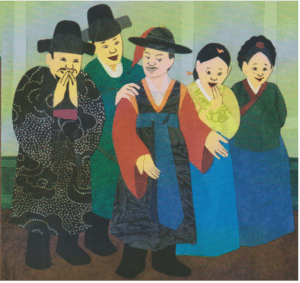
In pre-modern Korea, there were four social classes: royals and nobles, townspeople and merchants, commoners, and slaves or indentured servants. Strictly determined relationships dictated the interactions among royalty, aristocracy, townsfolk, villagers, and peasants. Thus, clothing, gestures, and even speech were used to mark social class so that people could know how to interact.
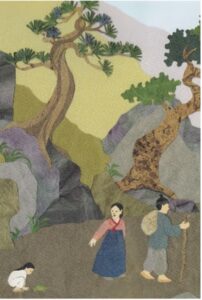
The character Sun-sin is the son of commoners from a poor fishing village, but he had a wonderful idea that he turned into an extraordinary invention. Many cultures have stories about people who rise above societal expectations through hard work and ability. Do you have an idea for something to improve society? Could you work hard to turn your idea into a reality?
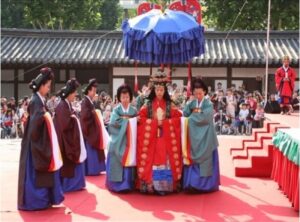
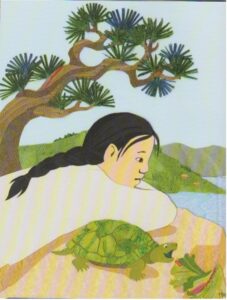
Authors:
Hye-Seung (Theresa) Kang, Ph.D., Director, Indiana University NCTA National Coordinating Site; Associate Director, East Asian Studies Center
Perry Miller, Ph.D., EdD Student in Literacy, Culture, and Language Education, Department of Curriculum and Instruction, Indiana University; Senior Lecturer, Department of East Asian Languages and Literatures, Ohio State University
2021
Publisher’s Teacher’s Guide

